

History of Computer Graphics (1972) A. Michael Noll. A.
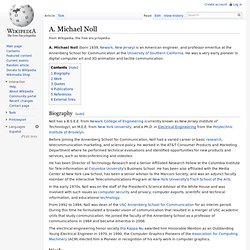
Michael Noll (born 1939, Newark, New Jersey) is an American engineer, and professor emeritus at the Annenberg School for Communication at the University of Southern California. A. Michael Noll. 4 computer patterns with lines. Rotatting hypercube. Georg Nees. Art[edit] Nees began programming computers in 1959.[3] Circa 1965, while working at Siemens in Erlangen, Germany, he began writing programs in ALGOL that used random number generators to generate drawings automatically by controlling a Graphomat Z64, a primitive flat-bed pen plotter designed by Konrad Zuse.[3][4] In order to create this art, Nees also wrote some of the world's first graphics libraries, packages named G1, G2, and G3 that extended the ALGOL programming language by adding commands for controlling a plotter and generating random numbers.[5] Nees's artwork "Sculpture" (1968) was one of the world's first computer-generated sculptures; it was exhibited at the 1969 Venice Biennale.
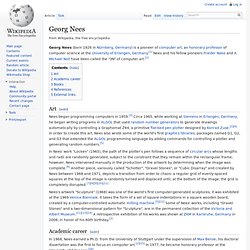
Academic career[edit] In 1968, Nees earned a Ph.D. from the University of Stuttgart under the supervision of Max Bense; his doctoral dissertation was the first to focus on computer art.[2][15] In 1977, he became honorary professor at the University of Erlangen.[16] Books[edit] Nees. Page51-1. Frieder Nake.
Frieder Nake Frieder Nake (born December 16, 1938 in Stuttgart, Germany) is a mathematician, computer scientist, and pioneer of computer art.
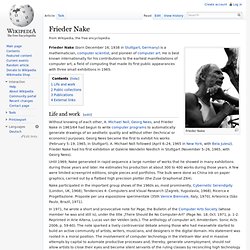
He is best known internationally for his contributions to the earliest manifestations of computer art, a field of computing that made its first public appearances with three small exhibitions in 1965. Life and work[edit] Without knowing of each other, A. Michael Noll, Georg Nees, and Frieder Nake in 1963/64 had begun to write computer programs to automatically generate drawings of an aesthetic quality and without other (technical or economic) purposes. Until 1969, Nake generated in rapid sequence a large number of works that he showed in many exhibitions during those years and later. Nake participated in the important group shows of the 1960s as, most prominently, Cybernetic Serendipity (London, UK, 1968), Tendencies 4: Computers and Visual Research (Zagreb, Yugoslavia, 1968), Ricerca e Progettazione.
Database of Digital Art. Frieder Nake belongs to the founding fathers of (digital) computer art.
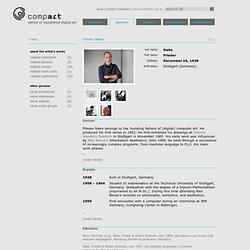
He produced his first works in 1963. He first exhibited his drawings at Galerie Wendelin Niedlich in Stuttgart in November 1965. His early work was influenced by Max Bense’s Information Aesthetics. Until 1969, he went through a succession of increasingly complex programs, from machine language to PL/I. His main work phases. Béla Julesz. Béla Julesz (February 19, 1928–December 31, 2003) was a visual neuroscientist and experimental psychologist in the fields of visual and auditory perception.
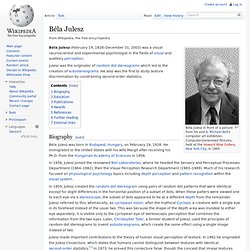
Julesz was the originator of random dot stereograms which led to the creation of autostereograms. He also was the first to study texture discrimination by constraining second-order statistics.
John Whitney (animator) John Whitney, Sr.

(April 8, 1917 – September 22, 1995) was an American animator, composer and inventor, widely considered to be one of the fathers of computer animation. In 1960, he founded Motion Graphics Incorporated, which used a mechanical analogue computer of his own invention to create motion picture and television title sequences and commercials. The following year, he assembled a record of the visual effects he had perfected using his device, titled simply Catalog. Arabesque (1975) Permutations. John Whitney-Matrix III (1972) John Whitney "Catalog" 1961. Charles Csuri.
Charles Csuri (born July 4, 1922), aka Chuck Csuri, is a pioneer in the field of computer art and a former All American college football player.[1] Digital art[edit] [edit] Csuri is in the Football Hall of Fame as M.V.P. in the Big Ten Conference and captain of the Ohio State University's first national championship football team in 1942.

He was a 16th round selection (154th overall pick) in the 1944 NFL Draft by the Chicago Cardinals. Time During World War II[edit] Csuri is a World War II veteran and served his country from 1943-1946. Hummingbird (Charles Csuri, 1968) Vera Molnar. Experiments in Art and Technology. Experiments in Art and Technology (E.A.T.) was a non-profit and tax-exempt organization established to develop collaborations between artists and engineers.
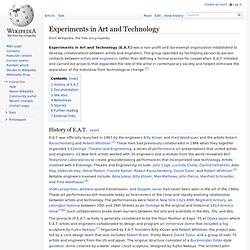
The group operated by facilitating person-to-person contacts between artists and engineers, rather than defining a formal process for cooperation. E.A.T. initiated and carried out projects that expanded the role of the artist in contemporary society and helped eliminate the separation of the individual from technological change.[1] Billy Klüver : E.A.T. - Les archives des documents publiés. Fondé en 1966 par les ingénieurs Billy Klüver et Fred Waldhauer ainsi que les artistes Robert Rauschenberg et Robert Whitman, Experiments in Art and Technology (E.A.T.) est un organisme sans but lucratif issu de l'expérience de 9 Evenings: Theatre and Engineering.
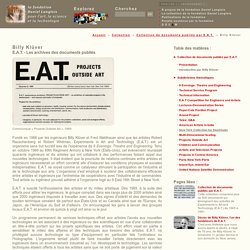
Tenu en octobre 1966 au 69th Regiment Armory à New York (États-Unis), cet événement réunissait quarante ingénieurs et dix artistes qui ont collaboré à des performances faisant appel aux nouvelles technologies. Il était évident que la poursuite de relations continues entre artistes et ingénieurs nécessiterait un effort concerté afin d'instaurer les conditions physiques et sociales indispensables. E.A.T. se voyait comme un catalyseur stimulant la participation de l'industrie et de la technologie aux arts. L'organisme s'est employé à soutenir des collaborations efficaces entre artistes et ingénieurs par l'entremise de coopérations avec l'industrie et de commandes.